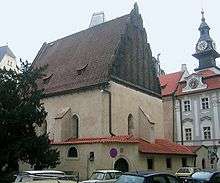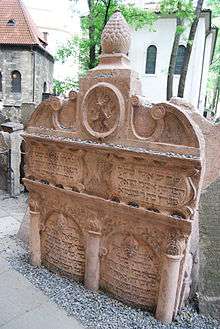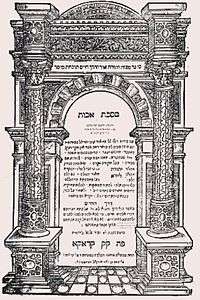Judah Loew ben Bezalel
| Judah Loew ben Bezalel | |
|---|---|
|
| |
| Personal details | |
| Born |
between 1512 and 1526? Poznań, Poland |
| Died |
17 September 1609 Prague, Bohemia |
| Buried | Old Jewish Cemetery, Prague |
Judah Loew ben Bezalel, alt. Löw, Loewe, Löwe, or Levai, (between 1512 and 1526? – 17 September 1609)[1] widely known to scholars of Judaism as the Maharal of Prague, or simply The MaHaRaL, the Hebrew acronym of "Moreinu Ha-Rav Loew," ("Our Teacher, Rabbi Loew") was an important Talmudic scholar, Jewish mystic, and philosopher who, for most of his life, served as a leading rabbi in the cities of Mikulov in Moravia and Prague in Bohemia.
Within the world of Torah and Talmudic scholarship, Loew is known for his works on Jewish philosophy and Jewish mysticism and his work Gur Aryeh al HaTorah, a supercommentary on Rashi's Torah commentary. He is also the subject of a 19th-century legend that he created The Golem of Prague, an animate being fashioned from clay.
Rabbi Loew is buried at the Old Jewish Cemetery, Prague in Josefov, where his grave and intact tombstone can still be visited. His descendants' surnames include Braude, Loewy, Loeb, Lowy, Oppenheimer, Pfaelzer, Lowenstein and Keim.
Biography


The Maharal was probably born in Poznań, Poland,[2]—though Perels[3] lists the birth town mistakenly[2] as Worms in the Holy Roman Empire—to Rabbi Bezalel (Loew), whose family originated from the Rhenish town of Worms. His birth year is uncertain, with different sources listing 1512,[3] 1520[4] and 1526.[2][5] His uncle Jakob ben Chajim was Reichsrabbiner ("Rabbi of the Empire") of the Holy Roman Empire, his brother Chaim of Friedberg a famous rabbinical scholar. There is no documented evidence of his having received formal religious education, leading scholars to conclude that he was an extremely gifted autodidact.[6]
His family consisted of his wife, Pearl, six daughters, and a son, Bezalel, who became a Rabbi in Kolín, but died early in 1600. He was independently wealthy, probably as a result of his father's successful business enterprises. He accepted a rabbinical position in 1553 as Landesrabbiner of Moravia at Mikulov (Nikolsburg), directing community affairs but also determining which tractate of the Talmud was to be studied in the communities in that province. He also revised the community statutes on the election and taxation process. Although he retired from Moravia in 1588 at age 60, the communities still considered him an authority long after that.
One of his activities in Moravia was the rallying against slanderous slurs on legitimacy (Nadler) that were spread in the community against certain families and could ruin the finding of a marriage partner for the children of those families. This phenomenon even affected his own family. He used one of the two yearly grand sermons (between Rosh Hashanah and Yom Kippur 1583) to denounce the phenomenon.
He moved back to Prague in 1588, where he again accepted a rabbinical position, replacing the retired Isaac Hayoth. He immediately reiterated his views on Nadler. On 23 February 1592, he had an audience with Emperor Rudolf II, which he attended together with his brother Sinai and his son-in-law Isaac Cohen; Prince Bertier was present with the emperor. The conversation seems to have been related to Kabbalah (Jewish mysticism, Hebrew: קַבָּלָה) a subject which held much fascination for the emperor.
In 1592, the Maharal moved to Poznań, where he had been elected as Chief Rabbi of Poland. In Poznań he composed Netivoth Olam and part of Derech Chaim (see below).
- Davidic Line
According to Jewish tradition, the Maharal's family descended patrilineally from the Babylonian Exilarchs (during the era of the geonim) and therefore also from the Davidic dynasty.[7]
Death
Towards the end of his life he moved back to Prague, where he died in 1609. He was buried in the Old Jewish Cemetery, Prague.
His name
His name "Löw" or "Loew", derived from the German Löwe, "lion" (cf. the Yiddish Leib of the same origin), is a kinnui or substitute name for the Hebrew Judah or Yehuda, as this name - originally of the tribe of Judah - is traditionally associated with a lion. In the Book of Genesis, the patriarch Jacob refers to his son Judah as a Gur Aryeh, a "Young Lion" (Genesis 49:9) when blessing him . In Jewish naming tradition the Hebrew name and the substitute name are often combined as a pair, as in this case. The Maharal's classic work on the Rashi commentary of the Torah is called the Gur Aryeh al HaTorah in Hebrew, meaning "Young Lion [commenting] upon the Torah".

The Maharal's tomb in Prague is decorated with a heraldic shield with a lion with two intertwined tails (queue fourchee), alluding both to his first name and to Bohemia, the arms of which has a two-tailed lion.
Influence
Disciples
It is unknown how many Talmudic rabbinical scholars the Maharal taught in Moravia, but the main disciples from the Prague period include Rabbis Yom Tov Lipmann Heller and David Ganz. The former promoted his teacher's program of regular Mishnah study by the masses, and composed his Tosefoth Yom Tov (a Mishnah commentary incorporated into almost all published editions of the Mishnah over the past few hundred years) with this goal in mind. David Ganz died young, but produced the work Tzemach David, a work of Jewish and general history, as well as writing on astronomy; both the MaHaRal and Ganz were in contact with Tycho Brahe, the famous astronomer.
Jewish philosophy
In the words of a modern writer, the Maharal "prevented the Balkanization of Jewish thought" (Rabbi Yitzchak Adlerstein 2000, citing Rabbi Nachman Bulman).
His works inspired the Polish branch of Hasidism, as well as a more recent wave of Torah scholars originating from Lithuania and Latvia, most markedly Rabbi Eliyahu Eliezer Dessler (1892–1953) as well as Rabbi Abraham Isaac Kook (1864–1935). A more recent authority who had roots in both traditions was Rabbi Isaac Hutner (1906–1980). Rabbi Hutner succinctly defined the ethos of the Maharal's teachings as being Nistar BeLashon Nigleh, meaning (in Hebrew): "The Hidden in the language of the Revealed". That is, the Maharal couched kabbalistic ideas in non-kabbalistic language. As a mark of his devotion to the ways of the Maharal, Rabbi Hutner bestowed the name of the Maharal's key work the Gur Aryeh upon a branch of the yeshiva he headed when he established its kollel (a yeshiva for post-graduate Talmud scholars) which then became a division of the Yeshiva Rabbi Chaim Berlin in New York during the 1950s, known as Kollel Gur Aryeh. Both of these institutions, and the graduates they produce, continue to emphasize the intellectual teachings of the Maharal. Rabbi Hutner in turn also maintained that Rabbi Samson Raphael Hirsch (1808–1888) (Germany, 19th century) must also have been influenced by the Maharal's ideas basing his seemingly rationalistic Weltanschauung on the more abstract and abstruse teachings of the hard-to-understand Jewish Kabbalah.
Rabbi Judah Loew was not a champion of the open study of Kabbalah as such, and none of his works are in any way openly devoted to it. Instead, what they attempt to do is to make the ideas of the Kabbalah (which he held to be the most deeply true of all the Torah) accessible to the average educated reader, by presenting them in a rigorously philosophical form, couched in terms that are accessible to the public. According to R. Loew, only the greatest of Torah scholars are able to perceive the full intent of the Kabbalistic works in their complex entirety. Therefore, although kabbalistic doctrine permeates his writings, it is always presented in a rational and philosophic form. His main kabbalistic influences appear to have been the Zohar, Sefer Yetzirah, and traditions of the Chassidei Ashkenaz, as Lurianic Kabbalah had not by that time reached Europe.
Faced with the Aristotelian interpretation of Talmudic Aggadot by Azariah dei Rossi, he was indignant at what he termed the trivialization of the Sages' deep wisdom. In his work Be'er ha-Golah he vigorously disputes all of dei Rossi's theses, sternly upholding the subtly allegorical nature of Aggadah and demonstrating its independence from (and superiority to) the superficial observations of natural science. At the same time he was entirely in favor of scientific research, so long as the researcher did not use his observations as permission to contradict the final authority of divine revelation. His constant thesis is that the Talmudic, Midrashic, and Aggadic teachings refer always to matters far beyond the competence of natural science.
Descendants
Among his many descendants were Schneur Zalman of Liadi, founder of Chabad Hasidism. Through him, he is the ancestor of many prominent later Jewish individuals, including Menachem Mendel Schneerson, seventh Rebbe of Lubavitch, and Yehudi Menuhin, the famous violinist. Maharal is also the ancestor of Rebbe Nachman of Breslov.
Legend of the golem
The Maharal is the subject of the legend about the creation of a golem, a creature made out of clay to defend the Jews of the Prague Ghetto from antisemitic attacks, particularly the blood libel. He is said to have used mystical powers based on the esoteric knowledge of how God created Adam.[8] The general view of historians and critics is that the legend is a German literary invention of the early 19th century. The earliest known source for the story thus far is the 1834 book Der Jüdische Gil Blas by Friedrich Korn.[9][10] It has been repeated and adapted many times since.
Works

- Gur Aryeh ("Young Lion", see above), a supercommentary on Rashi's Pentateuch commentary
- Netivoth Olam ("Pathways of the World"), a work of ethics
- Tif'ereth Yisrael ("The Glory of Israel"), philosophical exposition on the Torah, intended for the holiday of Shavuot
- Gevuroth Hashem ("God's Might[y Acts]"), for the holiday of Passover
- Netzach Yisrael ("The Eternity of Israel"; Netzach "eternity", has the same root as the word for victory), on Tisha B'Av (an annual day of mourning about the destruction of the Temples and the Jewish exile) and the final deliverance
- Ner Mitzvah ("The Candle of the Commandment"), on Hanukkah
- Or Chadash ("A New Light"), on Purim
- Derech Chaim ("Way of Life"), a commentary on the Mishnah tractate Avoth
- Be'er ha-Golah ("The Well of the Diaspora"), an explanatory work on the Talmudic and Midrashic Aggadah, mainly responding to interpretations by the Italian scholar Azariah dei Rossi (Azariah min ha-Adumim)
- Chiddushei Aggadot ("Novellae on the Aggada", the narrative portions of the Talmud), discovered in the 20th century
- Derashot (collected "Sermons")
- Divrei Negidim ("Words of Rectors"), a commentary on the Seder of Pesach, published by a descendant
- Chiddushim al Ha-Shas, a commentary on Talmud, recently published for the first time from a manuscript by Machon Yerushalyim on Bava Metzia; Shabbos, and Eruvin; others may be forthcoming.
- Various other works, such as his responsa and works on the Jewish Sabbath and the holidays of Sukkot, Rosh Hashana and Yom Kippur, have not been preserved.
His works on the holidays bear titles that were inspired by the Biblical verse in I Chronicles 29:11: "Yours, O Lord, are the greatness, and the might, and the glory, and the victory, and the majesty, for all that is in the heavens and on the earth [is Yours]; Yours is the kingdom and [You are He] Who is exalted over everything as the Leader." The book of "greatness" (gedula) on the Sabbath was not preserved, but the book of "power" (gevurah) is Gevurath Hashem, the book of glory is Tif'ereth Yisrael, and the book of "eternity" or "victory" (netzach) is Netzach Yisrael.
Commemoration
In April 1997 Czech Republic and Israel jointly issued a set of stamps, one of which featured the tombstone of Loew.[11][12][13] In May 2009 the Czech Post issued a stamp commemorating the 400th anniversary of Loew’s death.[14] In June 2009 the Czech Mint issued a commemorative coin marking the same milestone.[15]
See also
- André Neher
- Kerem Maharal, a moshav in northern Israel named in his honour
- Statue of Judah Loew ben Bezalel, Prague
Notes and references
- ↑ Bohemia, as a Catholic country, adopted the Gregorian calendar in 1584. On the Julian calendar it was 7 September. His gravestone, as quoted by Gal Ed, Megilas Yuchsin and others, gives his date of death as Thursday 18 Elul 5369.
- 1 2 3 ד"ר א. הכהן עובדיה Dr Avraham Hacohen Ovadia (Gotsdiner) (2001). Ha'ari Shebechachmai Prague (in Hebrew). Jerusalem, Israel: Mosad Harav Kook. p. 138. OCLC 145439809.
- 1 2 Meir Perels (1718). Megilas Yuchsin. Prague. OCLC 122864700.
- ↑ Nathan Grün (1885). Der hohe Rabbi Löw und sein Sagenkreis (in German). Prague: Verlag von Jakob B. Brandeis. OCLC 19037024.
- ↑ Luboš Jeřábek (1903). Der alte Prager Judenfriedhof (in German). Prague: Kunstverlag B. Koci. OCLC 1810845.
- ↑ YIVO Encyclopedia - Yehudah Leib ben Betsalel.
- ↑ See The Maharal of Prague's Descent from King David, by Chaim Freedman, published in Avotaynu Vol 22 No 1, Spring 2006
- ↑ Bilefsky, Dan (May 11, 2009). "Hard Times Give New Life to Prague's Golem". New York Times. Retrieved 2009-05-11.
The Golem, according to Czech legend, was fashioned from clay and brought to life by a rabbi to protect Prague’s 16th-century ghetto from persecution, and is said to be called forth in times of crisis. True to form, he is once again experiencing a revival and, in this commercial age, has spawned a one-monster industry.
- ↑ . Goethe Universität Frankfurt Am Main, freeman-Sammlung Universitätsbibliotheck. (2011-03-03). Retrieved on 2011-09-23.
- ↑ Kohn, J. S., Der jüdische Gil Blas, Leipzig, 1834, p.20
- ↑ 1997 Prague Jewish Monuments - Czech Joint Issue
- ↑ Jewish Monuments in Prague Joint Isuue, israelphilately.org.il
- ↑ Stamps: April ’97: The Altneuschul Synagogue, The Tombstone of Rabbi Judah Loew
- ↑ Rabbi Judah Loew, Česká pošta
- ↑ 2009 Czech 200Kr Silver Proof "Judah Loew"
Further reading
- Byron L. Sherwin, Mystical Theology and Social Dissent: The Life and Works of Judah Loew of Prague (Fairleigh Dickinson University Press, 1982)
- Rivka Schatz, "Maharal's Conception of Law- Antithesis to Natural Law" Jewish Law Annual Vol. VI.
- Rivka Schatz, "Existence and Eschatology in the Teachings of the Maharal" Immanuel 14 (Spring 1982) 66-97; Immanuel 15 (Winter 1982-3) 62-72.
- Moshe Zuriel "Numbers: Their meaning and Symbolism According to Maharal" [Hebrew] HaMaayan 18:3 (1978) 14-23; 18:4 (1978) 30-41, reprinted in Sefer Ozrot Gedolei Yisroel (Jerusalem:2000) volume 1, pp. 204–228.
- Martin Buber, "The Beginning of the National Idea" On Zion: The History of an Idea. (New York, Schocken Books, 1973).
- Otto Dov Kulka, "The Historical Background of the National and Educational Teachings of the Maharal of Prague" [Hebrew] Zion 50 (1985) 277-320.
- Benjamin Gross, Netzah Yisrael (Tel Aviv: Devir, 1974)
- Mordechai Breuer, "The Maharal of Prague's Disputation with Christians: A Reappraisal of Be'er Ha-Golah" in Tarbiz (1986) 253-260
- Adlerstein Y. Be'er Hagolah: The Classic Defense of Rabbinic Judaism Through the Profundity of the Aggadah. New York, NY: Mesorah Publications, 2000. ISBN 1-57819-463-6.
- Aharon Kleinberger, The Educational Theory of the Maharal of Prague [Hebrew] (Magnes: 1962).
- Andre Neher, Jewish Thought and the Scientific Revolution: David Gans (1541–1613) and his times (Oxford-New York: Littman Library, 1986)
- Neher, Faust et le Maharal de Prague: le Mythe et le Reel (Paris: Presses Universitaires de France, 1987);
- Neher, Le Puits de l'Exil: la Theologie Dialectique du Maharal de Prague (Paris: A. Michel, 1996)
- Neher, Mishnato shel ha-Maharal mi-Prague, Reʾuven Mass,c2003.
- Gross, Benjamin, Yehi Or (Reʾuven Mass, 1995).
- Gross, Benjamin, Netsah Yiśraʾel Tel Aviv : Devir, 1974.
- Eliyahu Yaakov Deutsch, Shabbos Insights Of The Maharal Jerusalem: Targum, 2009.
External links
- YIVO Encyclopedia - Yehudah Leib ben Betsalel
- Gregor Brand (2008). "Löw, Juda (Yehuda, Jehudah, Yudah, Judah) ben Bezalel (auch Löwe, Löb, Livia, Liwa etc., Akronym: "MaHaRaL")". In Bautz, Traugott. Biographisch-Bibliographisches Kirchenlexikon (BBKL) (in German). 29. Nordhausen: Bautz. cols. 858–877. ISBN 978-3-88309-452-6.
- Yehuda Loew — The Maharal jewishvirtuallibrary.org
- Family tree
- Shiurim on Derech Chaim at Torah.org
Resources
- Tiferet Yisrael, Hebrew Full-text